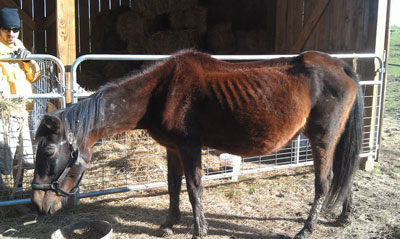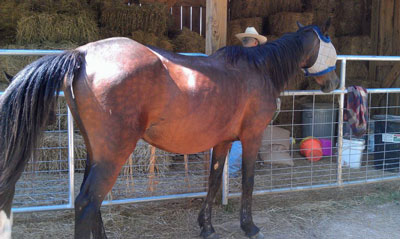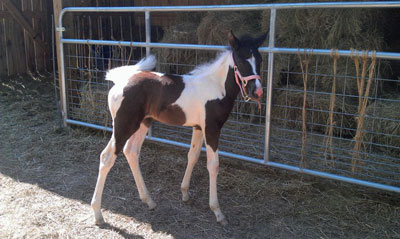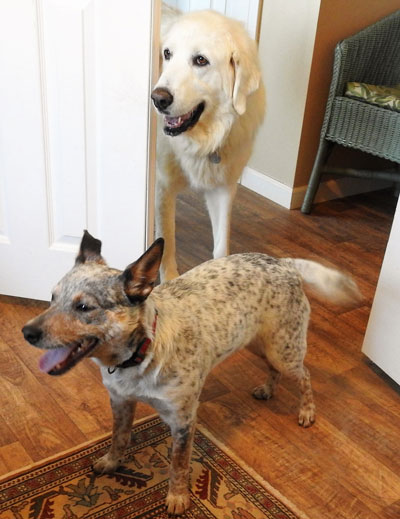

Our Animal Sanctuary
We feel a deep connection with our animals — and not just the Highlands. In addition to the cattle, we have fostered and rescued a variety of other animals in need. We often work with our local humane society and rescue groups to neuter, foster and rehome needy, homeless animals. To date we have been blessed with the successful rehoming of 26 dogs, 22 cats, one cow, and most recently a pony! Current residents include six rescued dogs, 11 rescued cats, and two rescued horses.
We have six peafowl who spend most of the day on the deck or porch begging for food. There are also 4 peafowl (somewhere in the neighborhood) who began life at Elm Hollow Farm and they grace us with their presence when they feel like it.
We have rehomed the 3 goats (who had gotten into a boat load of trouble at home by escaping the fence and holding a dance party on top of the neighbor’s new car) They had to find a new home and it was here where each of them blessed us with 2 playful kids. All 9 have now been rehomed.
Six dogs call Elm Hollow home. Our two female Great Pyrs came to us as puppies that were products of a puppy mill/flea market deal. They had been living in a muddy pen. I wish we could have taken the entire litter, but circumstances made that impossible. Our beagle was rescued from a chain situation near Knoxville and we were able to adopt him, our little rat terrier came from the animal shelter in Greeneville, and Mr. Max our male Great Pyr fell victim to the leash law in Rogersville. He needed room to roam and has fit in so well with our family. Then we saw a facebook plea for a Great Pyr in desperate need and we added Duke to our family. He has been a bit of a challenge, but he’s beginning to learn the ropes and I can say he has found his furever home here at Elm Hollow.
We finally had to call our feline population at capacity when we hit the magic #10. When fostering mamas with litters until the kittens were old enough for adoption, we would keep mamas and our population reached its max.
Elm Hollow for advocates for spaying and neutering of cats and dogs and adopting from local shelters. We also provide ongoing financial support to the Spay/Neuter fund of our local furry friends at the Hawkins County Humane Society.
Heritage Breeds
Heritage breeds are old and originally developed through the natural selection of unique characteristics that allowed them to survive in a particular climate. Basically, through Darwin’s theory of “survival of the fittest”. Newer breeds have been developed to meet the needs of an industrialized society by cross breeding in an attempt to improve the ability of a breed to produce larger quantities of consumable products for a growing industrialized society. The results have been fast growing larger breeds that produce more meat or more milk, but often at the expense of the health and longevity of the animal.
The loss of the unique breeds of particular regions is akin to the extinction of a wild animal species. These older breeds are hardier, have better mothering instincts, and are capable of surviving for the most part by foraging. These are ideal breeds for small self sustaining farms and could very well be part of the answer to feeding the hungry in 3rd world countries. There is an organization that promotes the preservation of heritage livestock breeds and it has been instrumental in the return of many old breeds. Please visit and if you choose to join or donate to The Livestock Conservancy.
Scottish Highland Cattle originated in . .wait for it . . . Scotland! The larger Highland cows came from the mountainous area and are mostly red. The lower lands also had a strain of the breed, but they were smaller and usually black. Here at Elm Hollow we have several colors of Highlands and you can see the structure of the true Scottish conformation in most of our cattle. When these cattle were brought to the US, they were quickly “beefed up” to compete with the meat production of Angus. We have some of the good strong “beefed up” version here also. So no matter which style or color you like, you have an excellent chance of finding the perfect calf here.





Horse Rescue
Our original horses, were very senior. Babe only lived a few months after moving here (at age 34), Rocky was with us until Feb of 2018 (age about 32) and Abby was almost 35 years when she passed this spring.
When Elm Hollow was just the Gellers’ place, we had a particularly wet spring. There was a horse rescue down the road that had just turned into a huge mud pit. We had plenty of fenced pasture on high ground and only two horses (that had been given to us when we first bought the property) . . . You see where I’m going with this . . . I called and invited the horses to come over for a few months. They did and when they went back home, a few were left behind.
Belinda came to us almost starved to death and very pregnant. She is in her mid 20’s now and recently moved to a new home as a companion for another rescue horse. We also couldn’t turn away our blind TWH and her daughter, Jazzy who sees out of only one eye and acts as her mama’s guide.
The photos show Belinda on intake, and looking much better after 6 weeks of TLC. The foal in the rescue pictures was born a week after Belinda was taken in and was so weak we had to hold her up to nurse the first few times. After 4 weeks, she was fat and sassy.
Foster Pets
Ahhhh, fosters . . . We have mastered the idea of fostering when it comes to dogs. You take them in, take care of them and find them a good home. No additions to the family (the four permanent canines act as socialization coaches). Here we see Gladys teaching Merle how to behave in the house.
However, we are foster failures when it comes to cats. I guess that explains 10 cats in the house and 1 in the barn. Possibly 2 in the barn . . . we call the second one shadow . . . he is dark and disappears when we turn on the light.
These are the most recent kittens, the alphabet litter. Ellie, Clarence, Alice and Doris (brother Beau was camera shy). Their mother, Fizzy is our newest feline resident.
We’ve taken in a half a dozen mother cats with kittens from shelters or rescues in the past two years. Raised the kittens and returned the family to the shelter or rescue. When the kittens are all adopted, we can’t stand to think of that lonely mama kitty, so back we go to get mama. 5 of those 6 mamas now live here with us.


